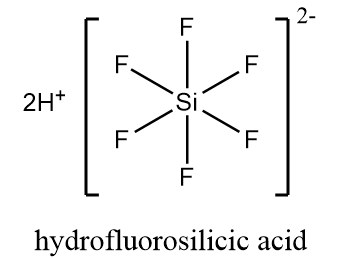
In hydrofluorosilicic acid, the covalency of
A.
B.
C.
D.
Answer
420.9k+ views
Hint :Mutual sharing of electrons between atoms to form stable compounds is known as covalent bonding. The maximum number of bonds an atom can form to gain stability in its uncharged state is known as its covalency. For example, in ammonia molecule i.e.,
Complete Step By Step Answer:
Hydrofluorosilicic acid also known as hexafluorosilicic acid is an inorganic compound with chemical formula
Structurally, hydrofluorosilicic acid is represented as follows:

In hexafluorosilicate dianion, silicon consists of six electrons in its valence shell which are shared by six fluoride ions to form
So, number of electron pair shared by silicon
Hence, the covalency of silicon (
Thus, option (C) is the correct answer.
Note :
It is important to note that although carbon and silicon belong from the same group but the maximum covalency shown by carbon atom is four whereas the maximum covalency shown by silicon atom is six because of presence of vacant d-orbitals in silicon, it can share all its valence electrons to form covalent bond.
Complete Step By Step Answer:
Hydrofluorosilicic acid also known as hexafluorosilicic acid is an inorganic compound with chemical formula
Structurally, hydrofluorosilicic acid is represented as follows:

In hexafluorosilicate dianion, silicon consists of six electrons in its valence shell which are shared by six fluoride ions to form
So, number of electron pair shared by silicon
Hence, the covalency of silicon (
Thus, option (C) is the correct answer.
Note :
It is important to note that although carbon and silicon belong from the same group but the maximum covalency shown by carbon atom is four whereas the maximum covalency shown by silicon atom is six because of presence of vacant d-orbitals in silicon, it can share all its valence electrons to form covalent bond.
Latest Vedantu courses for you
Grade 11 Science PCM | CBSE | SCHOOL | English
CBSE (2025-26)
School Full course for CBSE students
₹41,848 per year
Recently Updated Pages
Master Class 9 General Knowledge: Engaging Questions & Answers for Success

Master Class 9 English: Engaging Questions & Answers for Success

Master Class 9 Science: Engaging Questions & Answers for Success

Master Class 9 Social Science: Engaging Questions & Answers for Success

Master Class 9 Maths: Engaging Questions & Answers for Success

Class 9 Question and Answer - Your Ultimate Solutions Guide

Trending doubts
State and prove Bernoullis theorem class 11 physics CBSE

What are Quantum numbers Explain the quantum number class 11 chemistry CBSE

Who built the Grand Trunk Road AChandragupta Maurya class 11 social science CBSE

1 ton equals to A 100 kg B 1000 kg C 10 kg D 10000 class 11 physics CBSE

State the laws of reflection of light

One Metric ton is equal to kg A 10000 B 1000 C 100 class 11 physics CBSE




